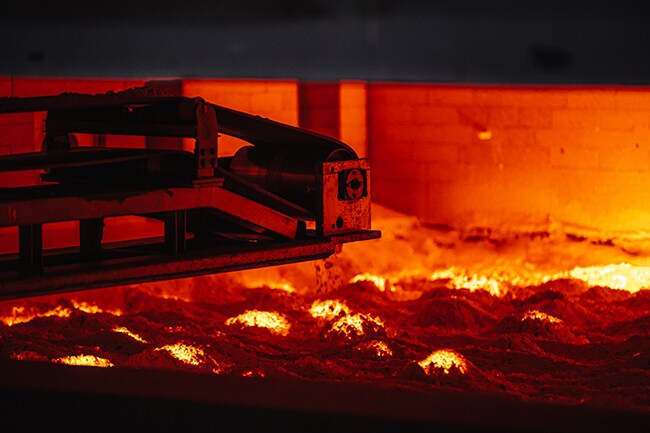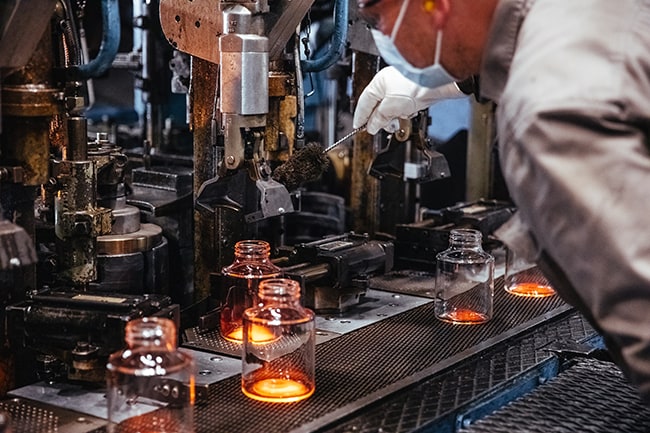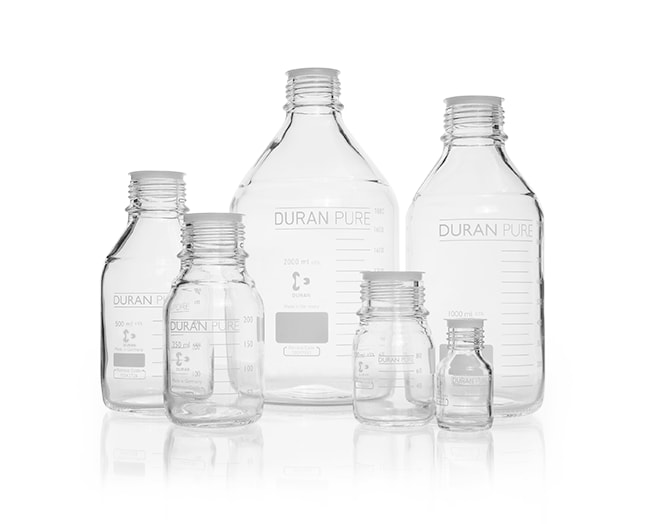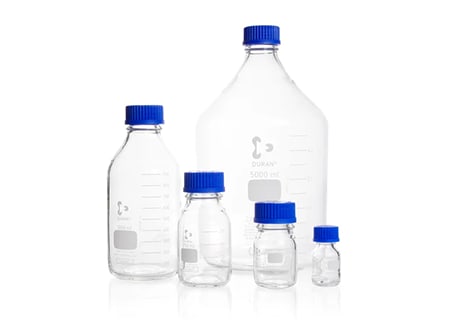DURAN™ Borosilicate 3.3 Glass: A Trusted and Safe Choice for In-Process Pharmaceutical Manufacturers
Alistair Rees, Product Manager, DWK Life Sciences and Chris Hogg, DWK Life Sciences
Today, borosilicate 3.3 glass is the material of choice in laboratories around the world. However, it also brings benefits to a wide range of additional applications, especially for pharmaceutical manufacturing and packaging. But what are the specific properties that make borosilicate glass an ideal choice for in-process pharmaceutical manufacturers?
Over 100 Years of History
The development of borosilicate glasses can be traced back to the late 19th century. In the 1880s, German chemist Otto Schott had an ambitious goal. He wanted to manufacture a glass which, in contrast to soda–lime glass or lead glass, would reliably withstand high temperatures and temperature changes, as well as be resistant to acids and alkalis. As his work progressed, one glass formulation was optimized as ‘borosilicate 3.3 glass’ and this was eventually given the brand name DURAN™ in 1938. This invention created the foundation for modern laboratory and industrial glass and now, 134 years later, DURAN™ glass remains a reliable choice in laboratories, industrial applications, and pharmaceutical packaging.
Glass Types Explained
To appreciate the benefits that borosilicate 3.3 glass provides, it is important to understand the difference between the various glass materials typically used in the laboratory, pharmaceutical, and industrial sectors, in particular the difference between European Pharmacopoeia (Ph. Eur.)/United States Pharmacopeia (USP)/ISO-defined glass types (Type I, Type II, and Type III glasses).1,2,3,4 The most crucial difference in relation to suitability for pharmaceutical packaging is that of hydrolytic resistance (HR).
Type I neutral glasses/borosilicate glasses, such as DURAN™ borosilicate 3.3 glass, possess high hydrolytic resistance. They are suitable for most preparations whether for parenteral use or not. Type II treated soda–lime glass also has relatively high hydrolytic resistance, although not as high as Type I borosilicate glasses. It is suitable for most acidic and neutral aqueous preparations whether for parenteral use or not. Type III soda–lime glass only possesses moderate hydrolytic resistance. It is only suitable for non-aqueous preparations for parenteral use, for powders for parenteral use, and for non-parenteral preparations.
The Composition and Advantages of DURAN™ Borosilicate 3.3 Glass
Many of the advantages of borosilicate glass are a direct result of its chemical composition. There are three basic components of all silica glasses: network formers, network modifiers, and intermediate species (which act as substitute network formers). Silicon dioxide (SiO2) is the main network former in silica glasses and is typically at 70 percent in soda–lime silicate glasses. Higher concentrations of SiO2 lower the thermal coefficient of expansion (COE) and increase chemical resistance, but also have the effect of raising the melting temperature. To reduce this melting temperature and thus make production easier, alkali oxides are added to act as network modifiers. However, the impact of this addition is a significant reduction in chemical resistance.
DURAN™ borosilicate 3.3 glass on the other hand contains a higher percentage of SiO2 as the main network former (81 percent). This offers a cost-effective compromise with the lowest COE of all commercial glasses for large-scale technical application. To be classified as a borosilicate glass a material must contain at least 5 percent boron trioxide (B2O3). At 13 percent, B2O3 acts as the network former, reducing the COE and slightly increasing chemical resistance. Finally, aluminium oxide (Al2O3) is added at 2 percent and acts as an intermediate species, increasing chemical resistance. Levels of alkali oxides, such as sodium oxide (Na2O) and potassium oxide (K2O), are reduced to 4 percent to provide improved chemical resistance. These materials are combined in a glass melting tank, as illustrated in figure 1.

The resulting material is one that contains several key features which make DURAN™ borosilicate 3.3 glass ideal for use in pharmaceutical primary packaging. These include very high hydrolytic resistance and impermeability to gases. It is also resistant to thermal shock and can be easily cleaned, sterilized, and depyrogenated. Furthermore, it can be manufactured as a transparent or amber-colored material and provides a rigid, strong, and dimensionally stable form.
Meeting Pharma Requirements
Pharmaceutical manufacturing is highly regulated and the materials used are subject to the highest safety and quality standards. Using DURAN™ borosilicate 3.3 glass to store, process, and transport pharmaceutical raw materials, as well as harvest/downstream intermediates, active pharmaceutical ingredients (APIs), and excipients, ensures compliance with a wide range of these standards. Firstly, DURAN™ borosilicate 3.3 glass meets the standards defined by ISO 35855 as well as the ASTM E438-926 Type I, Class A requirements. It is also non-cytotoxic in accordance with ISO 10993-57 and is ‘generally recognized as safe (GRAS)’ by the U.S. Food & Drug Administration.8 As a material that is very well characterized and with a long safety record, it is easier and quicker to validate for use in new processes compared to more recent products, such as containers made from polymer films. DURAN™ borosilicate 3.3 glass fully meets the key Type I glass hydrolytic resistance requirements as outlined in the USP (660) and Ph. Eur. (3.2.1) specifications for glass containers for pharmaceutical use. Finally, amber DURAN™ borosilicate 3.3 glass fully complies with requirements for UV light transmission as specified in USP (660)9 and Ph. Eur. (3.2.1).10
Borosilicate Glass Products and Accessories from DWK Life Sciences
DWK Life Sciences, the company behind DURAN™ borosilicate 3.3 glass, has a long heritage in the manufacture of labware. The company's roots can be traced back to Otto Schott’s earlier mentioned invention of borosilicate glass in 1887, as well as the founding of other leading scientific glass companies, including WHEATON™ and KIMBLE™. In addition to the manufacturing of DURAN™ borosilicate 3.3 glass itself, the DWK Life Sciences group also uses a range of glass manipulation techniques to enable borosilicate 3.3 glass to exist in a variety of forms, each with their own benefits and application specific purposes. An illustration of such a technique, that of DURAN™ glass bottle moulding, is shown in figure 2.

One of the most notable product ranges is the DURAN™ PURE bottle range, which is available in various volumes with both GL 25 and GL 45 threads (figure 3). DURAN™ PURE bottles are also available in amber to provide protection against UV light for stored substances. Here, the protection crucially comes from an amber coating, meaning the color is fused to the outer surface of the bottle only, resulting in the extractables profile of the inner glass surface being identical to that of the clear bottles. DWK Life Sciences also offers the DURAN™ GLS 80™ wide-neck range of bottles and a range of screw-cap closure options that are designed specifically for use in pharmaceutical applications.

In addition to being the original product manufacturer, with processes based on long-term commitments to quality and control, DWK Life Sciences also offers a range of technical and compliance support services to assist pharmaceutical customers. These include evaluation of technical drawings, product specifications and material specifications, as well as validation support material such as origin statements, DMFs, material compliance and extractables studies, ICH Q3D elemental impurity statements, and cytotoxicity and stability studies. DWK Life Sciences also offers supply control measures including lot-specific certificates, single lot delivery, product change notifications and quality agreements, and revalidation through manufacturing site audits and documentation reviews.
DWK Life Sciences: A Trusted Partner for Pharmaceutical Manufacturers
Through its specific composition, borosilicate glass possesses key features that make it a safe and trusted material for use in pharmaceutical production and primary packaging. By choosing DURAN™ borosilicate 3.3 glass for key applications, in-process pharmaceutical manufacturers are selecting a material that already conforms with a comprehensive range of safety and quality standards. By working with DWK Life Sciences it is not only the company's products but its range of accompanying services that provides pharmaceutical manufacturers with a trusted partner capable of supporting their work.
References
1. Chapter 660. Containers – Glass. USP.
2. Chapter 3.2.1. Glass containers for pharmaceutical use. Ph. Eur.
3. ISO 719:2020. Glass – Hydrolytic resistance of glass grains at 98 °C – Method of test and classification. www.iso.org/standard/77843.html
4. ISO 720:2020. Glass – Hydrolytic resistance of glass grains at 121 °C – Method of test and classification. www.iso.org/standard/77844.html
5. ISO 3585:1998. Borosilicate glass 3.3 – Properties. www.iso.org/standard/24774.html
6. ASTM E438-92(2018). Standard specification for glasses in laboratory apparatus. www.astm.org/e0438-92r18.html
7. ISO 10993-5:2009. Biological evaluation of medical devices – Part 5: Tests for in vitro cytotoxicity. www.iso.org/standard/36406.html
8. FDA Acknowledgement Letter ‘Food Contact Substance Formulation (FCF) 000127’.
9. Chapter 660. Containers – Glass: Spectral transmission for coloured glass containers. USP.
10. Chapter 3.2.1. Glass containers for pharmaceutical use: Spectral transmission for coloured glass containers. Ph. Eur.
To learn more visit: DWK Life Sciences DURAN™ PURE Clear Glass Bottles



